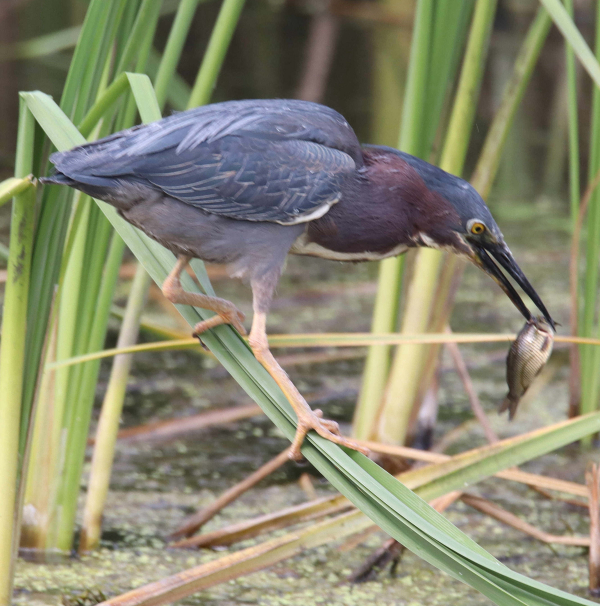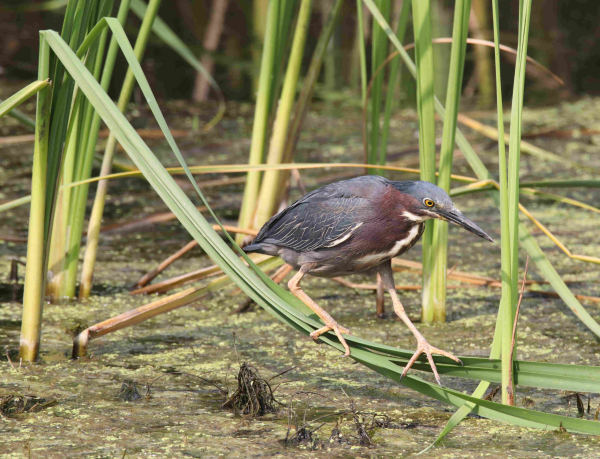
Poised on a rather precarious-looking perch of cattails, the Green Heron stretched stealthily toward an unsuspecting fish, providing a moment of anticipation as the strike was eminent (photo tech: 600mm zoom lens, f-7 aperture, 1/640 shutter speed, ISO 400).
During a recent birding trip I decided to check an easily accessible area of the James River Valley about 60 miles north-northeast of home that I’ve visited a couple times this season with the hope of finding Eastern Bluebirds and other species to photograph. No bluebirds were evident during this visit, but I noticed a Green Heron perched above a small open water area at the edge of a cattail stand that almost filled a shallow pond. I don’t often encounter Green Herons – anywhere – but especially across the open prairie and wetlands region of Dakota. yet in the few small river valleys of eastern Dakota they can be found along the James, Sheyenne, and Red Rivers and their associated floodplain waters.

The second fish caught by the trusting Green Heron was about twice the size of the first (600mm zoom lens, f-7 aperture, 1/320 shutter speed, ISO 400).
|
The Green Heron was in a pretty good location to try to photograph it, and you never know what the small heron might catch. If I could get close enough, it would be worthwhile to spend some extra time to see what might transpire – but first I needed to approach the bird successfully. I didn’t want to alarm the heron, especially because it was hunting, so caution was paramount. The heron was not far beyond the roadside, and frankly, as I eased my car ever-closer, the Green Heron didn’t appear to notice or react in any way – not even glancing in my direction.
Balanced on a few cattail stems bent low to the surface of shallow water, the heron was very focused on its hunt and caught a tiny fish to begin with, which it quickly followed up on by catching a little larger fish and quickly swallowed it as I photographed. With only the shortest pause, the Green Heron began repositioning on its long cattail perch, apparently focused on potential prey that I couldn’t see.
As the Green Heron “walked” down the cattail stems to the water’s edge, with one foot in the water it hesitated just a moment, then thrust its beak, head, and neck forward with a momentum that took the front side of its body into the water while spreading its wings overhead. In a single continuing movement the heron grabbed a larger fish in its beak, while flapping its wings and reversing its course back onto the cattail perch. It was quite an immersive and surprising move – all documented step by step with my camera with my zoom lens zoomed to the maximum 600mm magnification.

Before the Green Heron began stalking toward its next target, the ISO was increased from 400 to 800 to provide a faster shutter speed under the somewhat reduced sunlight, and the aperture was changed from f-7 to f-8 to expand the area in focus (600mm zoom lens, f-8 aperture, 1/1000 shutter speed, ISO 800).
The heron quickly swallowed the oversized fish and with its crop filled with a live fish, it flew about 100 yards away to perch within the leaved cover of a live tree – maybe to rest and digest. I peeled away after taking a quick look at the fast-action photos I managed, happy for the chance to spend a bit ‘o time in the company of an active Green Heron, a species I don’t often see and rarely get a chance to photograph – gracias amigo!
Tech Info
To begin with, when I first sighted the Green Heron, I instinctively checked the angle of the road in relation to the direction of the sunlight. I already knew the sun was behind me – always the preference – but the heron was positioned a bit to the left of the road, and the closer I tried to get, the poorer the angle was for optimum sunlight. With each foot I drove forward the shadows on the backside of the heron became a little stronger, so I actually found myself backing up a bit to improve the photo angle, relying on my Tamron 150-to-600mm zoom lens to magnify the heron and its surroundings.

The big payoff photo in the series was taken after the Green Heron thrust its beak, head, and neck forward with a momentum that took the front side of its body into the water while it spread its wings overhead (photo tech: 600mm zoom, f-8 aperture, 1/800 shutter speed, ISO 800).
The position of the Green Heron on the edge of the cattail maze slightly reduced the quality of the light, plus the scattered clouds added a bit of a now-it’s-good and now-it’s-not variance as I began photographing. That said, while the sunlight provided an on-again, off-again quality, the heron provided just as variable chances to compose and take photographs as it changed positions, showing its front side, backside, and full side as it stretched its neck and darted its beak into the water, then balanced to quickly swallowed the fish; almost immediately beginning to look for its next potential prey.

After flying back to its original position, the Green Heron quickly swallowed the larger fish and paused a moment before flying into the high cover of a nearby tree to end the much appreciated photo session (600mm zoom lens, f-8 aperture, 1/640 shutter speed, ISO 800).
|
As a result of the need for speed – a fast-shutter speed that is – with the edgy lighting conditions during the Green Heron’s considerably fast-action fishing behaviors, after taking my initial photos, I changed the ISO setting from my usual pre-set 400 to the 800 setting. I use that setting when light conditions are low or questionable – or when I want to ensure a faster shutter speed or broader aperture, or both. That change did give me a faster shutter speed, even when I increased the width of the aperture from f7 to f8 in an effort to expand the area in focus.
Overall, under the conditions, the photos turned out to be a nice series that represented the actions of the Green Heron as its fishing foray coincided with the period I was able to share a bit of time with the seemingly unaffected or unaware or uncaring bird. Or was it simply a trusting bird, something of a species ambassador the shared some time with me so I could share photos of its activities with you and other readers. It’s all fun to ponder, but maybe the biggest takeaway is to be aware of the potential of each bird you think might provide an opportunity to document its activities beyond a simple portrait. Enjoy the time you can spend with your camera in hand and a bird in sight.
Article and photographs by Paul Konrad
Share your bird photos and birding experiences at editorstbw2@gmail.com